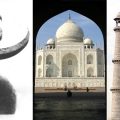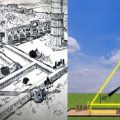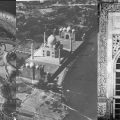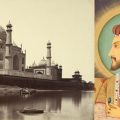Qutub Minar Was a Vedic Observatory: What Existing Hindu Motifs Prove
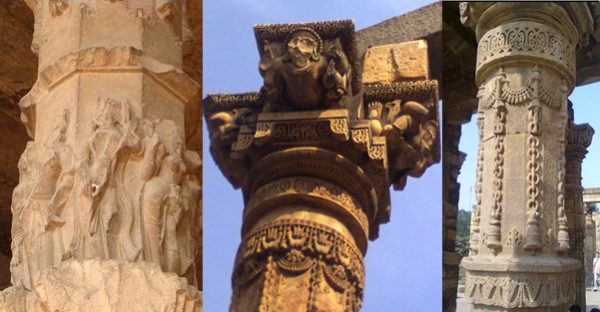
In Arabic “Qutub” literally means ‘axis’, ‘pivot’ or ‘pole’. Qutb can refer to celestial movements and used as an astronomical term or a spiritual symbol. So the term ‘Qutub Minar’ signifies an astronomical Tower. That was how it was described to Sultan and later referred to in court correspondence. In course of time the name of Sultan Qutubuddin came to be unwittingly associated with the Qutub Tower leading to the misleading assertion that Qutubuddin built the Qutub Minar.
The Historians were but all hired slaves of Moghul Rulers of those times and they found this tower named “Qutub” to be an opportunity to sing along the lines which pleased the barbaric slaves and intruders.
The Islamic intruders were never famous for creating the historical monuments of scientific utility or proportions but they were out to wipe off the history and culture of places they invaded, including India. Their concern was to loot the wealth and destroy the culture.There was no Indo Islamic Architecture but only Indian Architecture, Egyptian Architecture, Architecture of Bay of Pharas (Syria, Iraq and Iran ). Islam born only 400 years before Qutubuddin Aibak had no history of Architecture but only destruction right from the holiest place.
Unfortunately the English had access to only those records which somehow either survived in physical form, or in written form except for those well preserved records of the Muslim Invaders, which were recorded only to sing their praises. The culture of 8000 years antiquity was wiped off, step by step, only to be traced and accepted as the oldest civilized society 1000 years later.
True to their nature Qutubuddin has left us an inscription that he destroyed the pavilions of 27 Nakshatra temples, but he has not said a word that he raised any tower.
The translation of the inscription written on the walls of Mosque (done by Thomas in his book – Chronicles of Pathan Kings):
Kutb-ud-Din Aibak, on whom be the mercy of God, constructed this mosque.
This fortress was conquered and this Masjid Jami was built during the months of the year 587 by the great and mighty commander-in-chief Kutb-ul-Dawlat-wa-ul-Din, the commander of commanders, Aibeg Sultan. May God exalt his helpers. Materials from 27 idol temples, each of which cost twice thousand into thousand Diliwals, have been used in this Masjid. May Almighty God send mercy on him, who prays for the rest of the builder.
This fact has also been cited by R. N. Munshi in his book The History of the KutbMinar (Delhi, 1911).
It will not be out of subject to add a picture of Mr. Thomas’s observation in his book about the Majar Sharif at Ajmer, it should open the eyes of thought blinded Hindus about their past. ( Page no. 25, Chronicles of Pathan Kings)
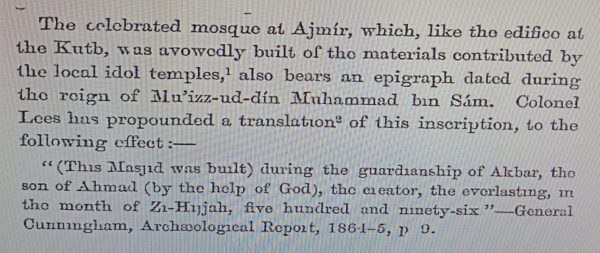
Qutub Minar was the observation tower of an observatory set up by the noted astronomist Varah Mihir much before the birth of Islam. It is estimated that this observatory was set up during 4th Century AD to 6th Century AD. The observatory provided major research in the field of astronomy and was the place where many calculations about the movement of planets and stars were performed and Vedic theories were validated.
The 12 conclusive evidences put an end to any theory or speculation that this tower was ever made by any Muslim Invader. They only did their part to damage and deform our ancient architectural and scientific heritage and ruin our cultural values.
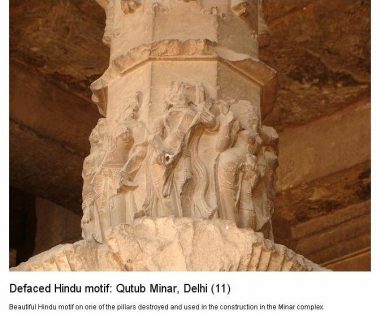
The Arial View
Truth about the Qutub Minar as a Hindu monument was revealed from the sky. Thanks to the research done by Shri M.S. Bhatnagar! He hired a helicopter to validate his theory. It is evident that the Qutub Minar is Dhruv Stambha or Vishnu Stambha.
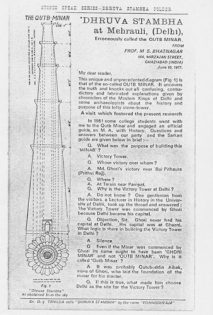
Source: gyanpanti.com
He provided ample proof in his original research which concludes that ruling Muslim sultans only defied its outer stone casing and reverse used the stones to inscribe Quranic Verses.
The Arial view of the Tower is an illustration of Astronomical Dial, representing the Zodiac (Rashis), and Hours of the day to measure the time and position during the movement of stars in different Zodiac Signs (Rashis). The Astronomical Dial is also illustrated below.
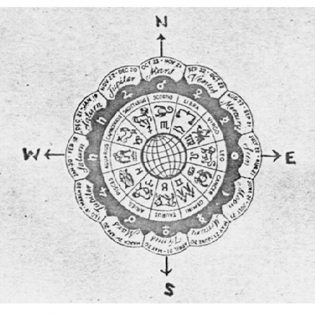
The outer wall of the Tower is similar to the Black Band in the Dial which having 24 segments, represents 24 Hours. Twelve complete dials of the structure on the ground refers to twelve zodiacs of astrological science. The expanse of the stories, their dimensions, proportions all indicate as if it is a plain paper cut out of the Zodiac Dial and expanded vertically into seven stories.
The Entrance Direction and Stone Lotus Flowers
All buildings made according to Vastu Shastra should have entrance from North and North East.
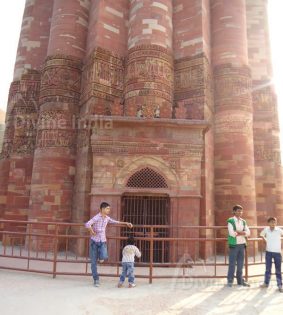
Source: Divine India
Noted historian P.N. Oak says “An important consideration is that the entrance to the tower faces north and not the west as is Islamic theology and practice.
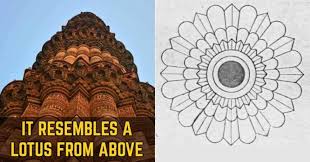
Source: TopYaps
At either side of the entrance (see the picture above) is the stone lotus flower emblem which also proves that it was a Hindu building. The stone flowers are a very important sign of the Hindu author- ship of medieval buildings. Muslims never use such flowers on the buildings they construct.”
The Seven Stories and 27 Windows
The tower had seven storeys which represents the 7 days of a week. At present, only five storeys exist. The sixth was dismantled and the seventh storey had the statue of Brahma with the instruments to observe the Stars and positions of constellations. It requires further research by studying the remains on the ground and underneath. There are 27 openings while we go up from the stairs, all set in the direction of each Constellations (Naksahtra) to have a view of the planetary movement in the sky.
Since there were 27 temples and Qutub Minar has 24 edges (indicating Hora) on base, this clearly proves that it was an observatory to study the Constellation movement. A portion of the temple is still intact in the Quwwat-ul-Islam Mosque. Its placement and design is the detrimental proof.
The Architecture
The circular arrangement of stairs, the proportions of the central pillar and outer petals, the height of each storey and the missing two storeys all point to Scientific Geometry. They represent perfect golden ratio in all its measurements, which was unknown to slaves. There is no question that a Slave made into a Sultan can have such architects and masons who will conceptualize, make detailed drawings, calculate each proportion and start the actual work in four year’s time, as if he started to work on this Minar from the very first day of his rule. It is also not possible that all the technology was available in Arabia, which he readily brought and employed.
Hindu ‘Bell and Chain’ Motif
Bell and Chain Motif of Vedic / Hindu origin is very much seen on the walls of Qutub Minar. If this minar was constructed by a Muslim Ruler, there is no chance that they would allow the use of such motifs to go in the interior and exterior walls. The fact that the Vedic signs and motifs are still seen clearly establishes that the sole purpose of the Muslim rulers was to deface the structure, break the idols and insert Arabic inscriptions on the stone to give this structure a false Islamic identity.
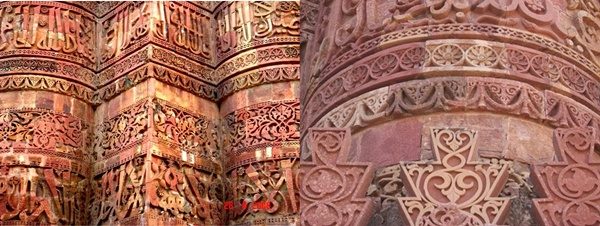
Hindu ‘Bell and Chain’ Motif on the Main Wall
Bell and Chain Motif on the Pillars
The bell and chain motif shown above on the walls of main tower are also visible on the Temple Columns and other architectural pieces in the complex.
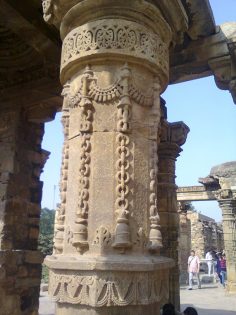
Bell and Chain Motif on Temple Columns
If the tower was made by a Muslim Ruler then either he was dumb or had no religious resources in his own religion that he allowed the copy the same motifs (of the culture he intended to destroy) in his brand new architectural wonder!
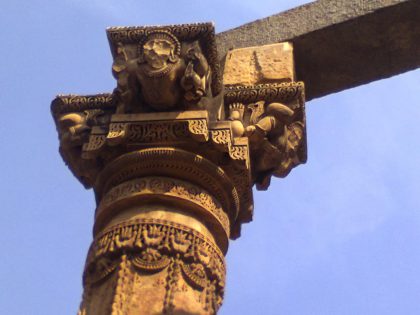
Bell and Chain Motif and Yaksha on Temple Columns
The Authenticity of the Arabic Verses
The writing of Sir Sayyid Ahmed Khan in his book Asar-ul-Sanadid translated into English by Fatima Quraishi who works as Assistant Curator at the Mohatta Palace Museum in Karachi, Pakistan, says,
“The Kutub cannot be a minaret because the column’s door is north-facing similar to Hindu temples, while the doors of minarets are always east facing…. The structure’s first level also shows evidence of stones being placed at a later stage and there is evidence of the bell-and-chain motif of Hindu temples on the first floor. Additionally, the inscription on this pillar is similar to that of Qutbuddin Aibak and Muʿizzuddin’s conquest on the converted temple-mosque.”
The text also states,” …there is nothing odd in the fact that epitaphs have been inscribed where idols once were…..when the Muslims conquered the temple, they added their own epigraphs upon the building’.
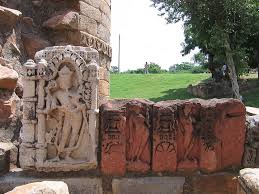
Hindu stone sculpture within the Qutub Minar complex
About the Islamic inscriptions Sir Sayyid Ahmed Khan says,
“….. Often, the shape of letters has been made out, but close inspection reveals that they are incorrect, in some cases just imitations of alphabets, and in other cases words which have little to do with the subject of the inscription. Until today, the inscriptions of this monument had not been read. I have read them with the aid of a telescope”.
Until today, the inscriptions of this monument have not been read. The need to study the Arabic verses on the outer claddings in detail and to translate each plate is of importance as all the inscriptions were done by the Hindu or forcibly converted Hindu masons. They always left their code signs or marks as evident from the Taj Mahal and Fatehpur Sikri. If proper research is done we can very well know some more facts of our lost history.
Qutubudin Aibak and his Rule: Historical Facts
Historians like Dr. Triveda have found numerous proofs that he neither had funds, nor time (in his tiny 4 year regime), to build, or even commence such a majestic structure. It appears that associating it with Sultan Qutb-ud-din Aibak was a “historian’s mistake”. Hasan Nizami dedicated his work Taj-ul-Maasir (the crown of exploits) to Sultan Aibak and also mentioned major events from the period of his predecessor and successor. There is no reference to any such minar in this important piece of work, which talks about period after 7 years of death of Aibak. If Qutubuddin Aibak even dreamed about (if not commissioned) this minar, then we must have found at least some mention in this book. But Hasan Nizami do talk about the a Jami Masjid built by Aibak.
The Astronomical Proof
Shri Arun Kumar Upadhyay, IAS, has verified in his study the scientific reasons of this minar. He writes that in Delhi, its semi-vertical angle is equal to difference between true and mean latitude there. That was not known to western astronomers till 1850 AD. In 456 BC at start of Sri-Harshashaka (Al-Biruni, Abul Fazal), it was place of northern most position of moon on earth surface (inclination of earth’s axis 23.90 + inclination of moon’s orbit with ecliptic 5.020) -Refer Siddhanta-Darpana, chapter 16. A pillar of 12 units was used to measure time and latitude of a place. It is called Shanku in Surya Siddhanta etc. Smallest shadow is at noon time and locus of shadow end around that time is in shape of a ‘Kutup’ called kuppi (funnel, thistle-kip) in Hindi. So, the muhurtta at noon time is called Kutupa-Muhurtta. By bisecting the shadow line equali-spaced from noon, say at 11 and 13 hrs, we get north–south direction. This is explained as traversing in books of astronomical survey for M.Tech (civil). The bisection is by common part of two circles in shape of a ‘Mina’ (fish), so the pillar is called Kutup-Mina.”
Magnetic compass does almost same work, so it is called Kutup-Mina (Later changed to Kutip Numa). In that also, needle floating on mercury is called ‘Mina’. Local references of latitude also have been given name of fish like Rohataka (almost at longitude of Ujjain) and Hilsa near Patna (100 east of Ujjain).
Mapping of the earth’s surface of north (and south) hemisphere was in 4 sheets of 900 longitude width. It was centered round north pole called Meru or Sumeru. Bharata-varsha (India) has been called one of the 4 petals of that lotus (earth surface) as it roughly extends 450 west and 450 east of Ujjain. Thus, Meru has 4 faces and its linga (symbol) has square base-called Svayambhulinga as in Kaaba of Arab at west end of Bharata. Pyramids were constructed 450 and 1800 west of Ujjain in Egypt and at Mexico (called Siddhapura in Surya Siddhanta) –Valmiki Ramayana, Kishkindhakanda (40/54, 64). South pole was called Kumeru (opposite to Sumeru in north). Aryabhata (Kali 360 = 2742 BC).
Even now it is difficult to build an accurate cone whose axis is inclined 50 south. Since Mahabharata till 1850, earth had been assumed spherical in all calculations. Semi-vertical angle of Qutub Minar is equal to difference between true and mean latitude of Delhi.
The 360 Steps
In my research I tried to find the authentic record of exact no. of steps (stairs) as there was no authentic record of steps from the Historians owing to the fact that it was repaired by different slaves, during their reign and they did not respect its original architecture. During my research I found a book named The History of Kutb Minar ( Delhi ) by Mr. R.N. Munshi, published in 1911 and preserved at “The US Southern Regional Library Facility” U.S.A. In page no. 8 and 9, he provides the dimensions of the minar taken at different periods by the historian and interestingly it mentions the correct no. of steps, when it was in its original shape. Quote:
“Abul Fida, a celebrated geographer who flourished at the end of the 13th and the beginning of the 14th century, had visited the Minar twenty years prior to the accession of Firozeshah. He records that it had 360 steps in its circular ascending stair-case. Now, considering that the utmost limit this monument is known to have reached under all subsequent additions is 379 steps that is, 19 more than the computation of our geographer, and looking to the fact that the Minar a portion whereof had been struck by lightning, was repaired by Firoze Shah in 1368 A. D., there is nothing improbable in the account of AbulFida that the Minar in his time counted only 360 steps”.
This agrees with the statement of Firoze Shah himself who had repaired it in 1368 A. D. when it had been struck by lightning. He says ” The Minara of Sultan Muizud-din Sam had been struck by lightning. I repaired it, and raised it higher than it was before.”
The point is why would there be exactly 360 steps denoting a Lunar Year? The Islamic fools did not have any idea of this and made 19 more steps without knowing the exact purpose and height to make a correct angle of shadow and constellation calculations from the ground and from the openings in the stair wall.
The Name Says It All
Archaeological evidences suggest that this area was settled by Ashoka about 2500 years ago. Mehrauli comes from Sanskrit word Mihira-awali. It signifies the township where the well known astronomer Varah Mihira also called Mihir, who wrote the famous book ‘Vrihatsamhitayam’ of Vikramaditya’s court lived along with his helpers, mathematicians and technicians. Delhi however gained in magnificence / importance during the time of Ananga Pala Tomara in the 11th century. In the 12th century, the city was included in the dominions of Prithviraj Chauhan.
Muslim Forgery Exposed
Stones dislodged from the minar have Hindu images on one side and Arabic inscription on the other side. Those stones have been removed to the museum. These stones clearly show that the Muslim invaders only removed the outer dressing of the tower and reversed the stones with Arabic Inscriptions and fixed them as is. They did not even bother to make the stones of the same dimensions, engrave Arabic inscription and fix them in place of the original stones.
Shri Stephen Knapp, noted expert in Vedic and Hindu Culture found out the truth.
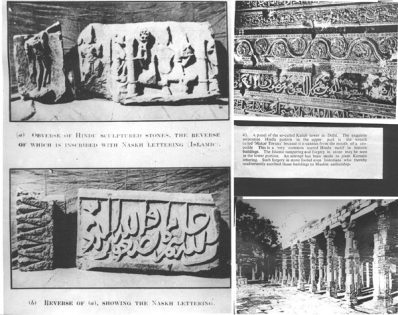
Qutub Minar snapshots; Source: Stephen Knapp
The above photos discovered by Shri Stephen Knapp are in, “black and white and found in a simple album in India”. Except for old age and some water damage on some of them (creating white spots in areas), most are still in relatively good condition. They all have the stamp on the back which states, “Archaeology Survey of India,” verifying their authenticity.
Each photograph was accompanied by a typed caption taped in the album near the photo, explaining the subject of the photo and what it means.
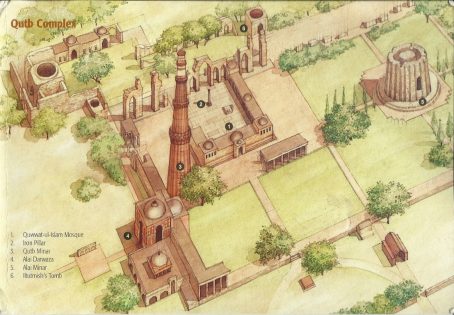
The above is an Arial draft view of the complex which needs further studies as regards to set up of an observatory and Vedic Temple Complex.
Expecting the truth of the Qutub Minar may be revealed by the historians using modern technology in times to come.
Ref Source: All the information in this article is collected from various sources with proper record and can be authenticated, from the original sources. More than 80 papers and books were consulted and help sought from the published material on the internet such as ‘Kutub Minar or Dhruv Stambh‘ to make this article. The Collector of this information is indebted to various scholars, historians, who risked their career in bringing out the truth in the times of dark hours of Indian History and Politics.
Disclaimer: The views expressed here are solely of the author. My India My Glory does not assume any responsibility for the validity or information shared in this article by the author.

